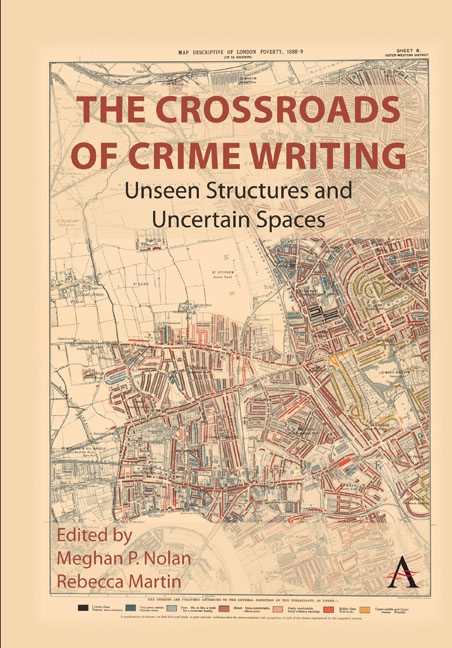Book contents
- Frontmatter
- Contents
- Introduction
- Unseen Structures
- Chapter 1 Unseen Structures and the Outlaw: Depictions of Violations in Stieg Larsson’s Millennium Trilogy
- Chapter 2 Dark Waters: Eco-Noir in New York 2140
- Chapter 3 Between Lenin and Sherlock Holmes: Soviet Militsiya Procedural in Volodymyr Kashin’s Detective Fiction
- Chapter 4 Detecting Justice: Black Crime Fiction and the Novels of Attica Locke
- Chapter 5 The Police and the Private Eye: The Making of Gendered and Racial Peripheralization in the Crime Fiction of Valerie Wilson Wesley
- Uncertain Spaces
- Chapter 6 Navigating the Carceral City: Calcutta in Late Nineteenth-Century Narratives of Detection
- Chapter 7 Traversing the Borders of Poverty and Morality: The Intersection of Maps and Upper-Class Ethics in Anne Perry’s Neo-Victorian Series
- Chapter 8 Facts and Fictions: The Liminal Space Between True Crime and Crime Fiction
- Chapter 9 The Success(Ion) and Corruption of Crime Genres in Jo Nesbø’s Macbeth (2018)
- Chapter 10 The Golden Age Meets the Age of Aquarius: Agatha Christie in the 1960s
- Notes on Editors and Contributors
- Permissions
- Index
Chapter 8 - Facts and Fictions: The Liminal Space Between True Crime and Crime Fiction
Published online by Cambridge University Press: 13 April 2024
- Frontmatter
- Contents
- Introduction
- Unseen Structures
- Chapter 1 Unseen Structures and the Outlaw: Depictions of Violations in Stieg Larsson’s Millennium Trilogy
- Chapter 2 Dark Waters: Eco-Noir in New York 2140
- Chapter 3 Between Lenin and Sherlock Holmes: Soviet Militsiya Procedural in Volodymyr Kashin’s Detective Fiction
- Chapter 4 Detecting Justice: Black Crime Fiction and the Novels of Attica Locke
- Chapter 5 The Police and the Private Eye: The Making of Gendered and Racial Peripheralization in the Crime Fiction of Valerie Wilson Wesley
- Uncertain Spaces
- Chapter 6 Navigating the Carceral City: Calcutta in Late Nineteenth-Century Narratives of Detection
- Chapter 7 Traversing the Borders of Poverty and Morality: The Intersection of Maps and Upper-Class Ethics in Anne Perry’s Neo-Victorian Series
- Chapter 8 Facts and Fictions: The Liminal Space Between True Crime and Crime Fiction
- Chapter 9 The Success(Ion) and Corruption of Crime Genres in Jo Nesbø’s Macbeth (2018)
- Chapter 10 The Golden Age Meets the Age of Aquarius: Agatha Christie in the 1960s
- Notes on Editors and Contributors
- Permissions
- Index
Summary
Introduction
True crime and crime fiction are sibling rivals in an increasingly crowded, and often increasingly profitable, publishing market that lures writers of crime-focused material with the idea that crime might pay after all. Publishers also look to crime works for profits and publicity. Readers consume the stories of criminals and their victims for numerous reasons, including satisfying voyeuristic interests of prurience, indulging in Schadenfreude in criminal activities, learning about crime in their communities, and the desire to solve the ultimate puzzle: murder.
Both true crime and crime fiction writing engage with the subject of the malefactor, usually the murderer. Both types of writing have long histories, and both have enjoyed widespread popularity through an ability to regularly update a tried and tested storytelling formula in response to changing reader expectations as well as changing social views on crime and punishment. Both, too, routinely feature on nonfiction and fiction lists of bestselling titles.
These two writing traditions obviously share a genealogical lineage; yet a clear segregation has been developed by writers, publishers, and consumers. This is most overtly seen in labeling practices and in how these works are traditionally separated in bookstores and in libraries.
True crime and crime fiction are generally associated by booksellers and librarians through carefully planned geographical proximities that allow people—be they browsers, buyers, or borrowers—to transition easily from one section to another. Occasionally, neat rows of shelving face each other in a primitive fact versus fiction standoff, almost daring readers to make a choice and commit to either those texts that assert the truth and offer information or those volumes that make no such claims to the real and seek, primarily, to entertain. Clear signage denotes the subject matter of “crime” but while true crime and crime fiction texts, as argued here, are always related, with the boundaries between them often becoming distorted, these works are rarely fully integrated under a single banner of “crime writing.”
This chapter unpacks the liminal space between true crime and crime fiction, looking at how often only a few more facts or a few more fictions can be required for a writer to realign their work, to deliberately remove one crime writing label and effortlessly apply the other.
- Type
- Chapter
- Information
- The Crossroads of Crime WritingUnseen Structures and Uncertain Spaces, pp. 169 - 190Publisher: Anthem PressPrint publication year: 2024



